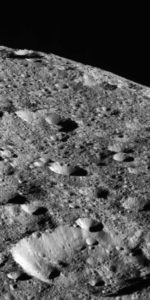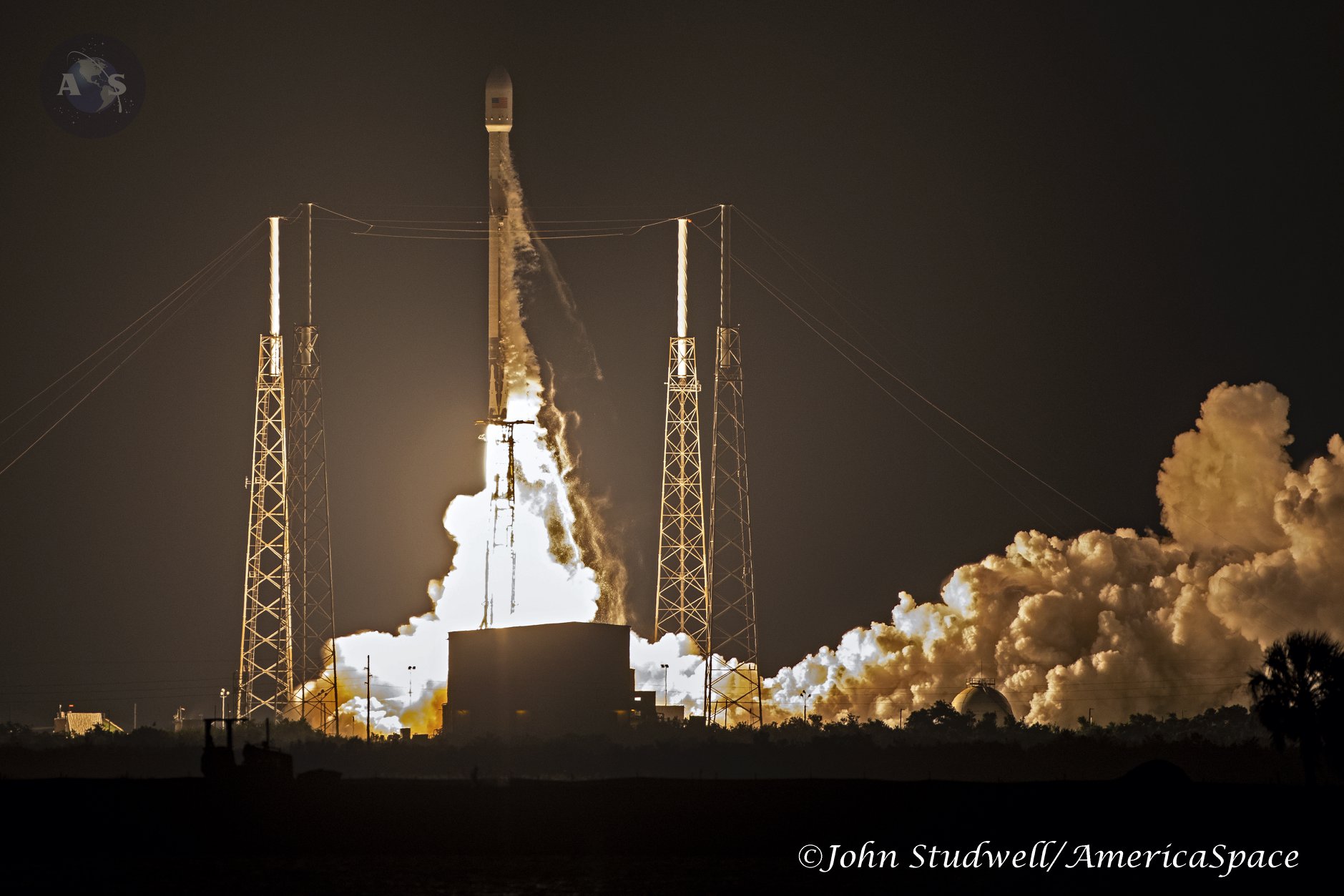
After several days of weather-related delay, SpaceX’s long-running partnership with Luxembourg-based satellite operator SES bore fruit in the small hours of Monday, 4 June, with the launch to Geostationary Transfer Orbit (GTO) of the heavyweight SES-12 payload atop an Upgraded Falcon 9 booster from Space Launch Complex (SLC)-40 at Cape Canaveral Air Force Station, Fla. It was the sixth SES bird to be lofted by SpaceX, following SES-8—its very first customer to geostationary orbit—way back in December 2013 and, more recently, SES-9 in March 2016, last year’s SES-10 and SES-11 and SES-16/GovSat-1 in January. When it reaches its final orbital position at 95 degrees East longitude, SES-12 will be co-located with SES-8 and will replace the aging, 16-year-old NSS-6 satellite, providing direct-to-home and high-throughput communications services in the Middle East and the Asia-Pacific region, reaching 18 million homes and supporting rapid-growth markets in India and Indonesia.
Tonight’s mission was the 11th SpaceX mission in the first half of 2018, coming on the back of a rapid-fire tempo of two launches every month, since January. Next up will be the CRS-15 Dragon cargo flight to the International Space Station (ISS) in late June, which is being conducted under the Commercial Resupply Services (CRS) contract with NASA.
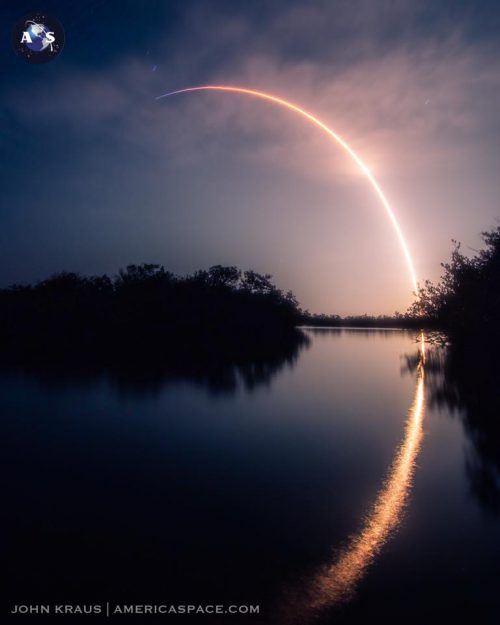
Only six months into 2018, on the eve of tonight’s launch, SpaceX had already flown ten missions, including the maiden voyage of its long-awaited Falcon Heavy booster in February and the first flight of the uprated “Block 5” variant of its Falcon 9, which will eventually carry astronauts to the International Space Station (ISS), under the Commercial Crew Program (CCP). During the course of these flights, payloads have varied from the classified Zuma for an undisclosed U.S. Government customer, the CRS-14 Dragon cargo mission to the International Space Station (ISS), NASA’s Transiting Exoplanet Survey Satellite (TESS), Bangladesh’s first communications satellite and SpaceX CEO Elon Musk’s cherry-red Tesla Roadster. When placed in context, even 2017’s personal-best-beating 18 SpaceX launches had achieved barely half of this number by mid-year. Coming up in the second half of 2018, the Hawthorne, Calif.-based launch services organization plans its first operational Falcon Heavy mission, a further pair of ISS-bound Dragon cargo flights and the completion of the Iridium NEXT constellation.
Weighing an estimated 11,680 pounds (5,300 kg), SES-12 is the most powerful and flexible satellite in SES’s fleet. Built on Airbus Defence and Space’s three-axis-stabilized EuroStar-3000 “bus”, it is equipped with frequency-agile remote-controlled Flexible Command Receivers to effect a more robust operations control link. Its twin solar arrays provide an electricity-generating capability of 13 kilowatts and the EuroStar-3000 was the first commercial satellite family to employ lithium-ion batteries in place of older nickel-cadmium ones for power during periods of orbital eclipse. The bus also benefits from a bi-propellant chemical thruster system for initial orbit-raising and maneuvers and an electric plasma propulsion system for station-keeping at GTO. It is anticipated that SES-12 will remain fully functional for at least 15 years.
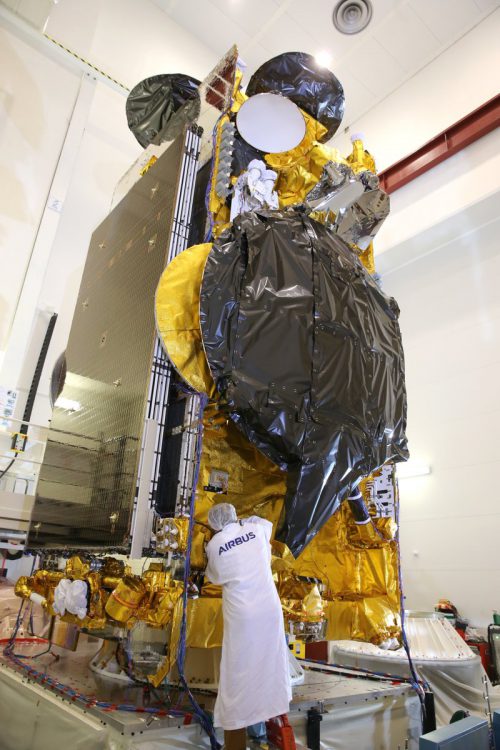
Contracts to build SES-12 were signed in July 2014, with Airbus Defence and Space selected as prime contractor. With its 68 high-power physical Ku-band transponders and eight physical Ka-band transponders, the satellite would expand SES’s capabilities to provide direct-to-home broadcasting, Very Small Aperture Terminal (VSAT), mobility and high-throughput data-connectivity services in the Asia-Pacific regions, including over 18 million households in India and Indochina. A “hybrid” platform, SES-12 will provide traditional, wide-beam coverage and a state-of-the-art replacement and growth capability for SES’s existing direct-to-home, government and VSAT customers—as NSS-6 operations draw to a close—together with Ku-band/Ka-band support for VSAT, enterprise, mobility and government applications. SES-12 also includes a Digital Transparent Processor (DTP), equipped with anti-jamming capabilities and increased payload flexibility to provide customized bandwidth solutions to customers.
In January 2015, Europe’s Arianespace organization was contracted to deliver SES-12 to orbit, atop its Ariane 5 heavylift booster, with launch originally targeted for late 2017. SES also reached agreement with SpaceX to launch its SES-16/GovSat-1 and SES-14 satellites aboard Falcon 9 vehicles. Plans changed last summer, when SES announced that it had switched launch providers. SES-12 would now fly atop an Upgraded Falcon 9 and SES-14 would ride an Ariane 5. “The swap of launches,” it was explained, “will enable SES to improve service quality and continuity for its customers.”
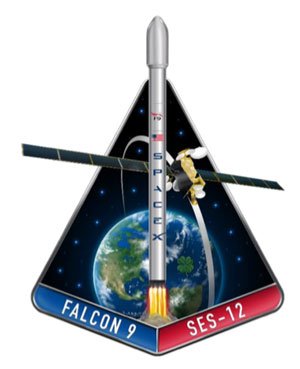
In April 2018, the satellite was delivered from Airbus’ facility in Toulouse, France, to the Cape for pre-launch processing. “SES-12 was built to meet the dynamic needs of our customers across the Asia-Pacific region and to empower them to capture massive growth opportunities in their markets,” said SES Chief Technology Officer Martin Halliwell. “When co-located with SES-8, it will provide incremental high-performance capacity and offer greater reliability and flexibility to our video and data customers.”
Today’s mission is the 13th mission since March 2017 to benefit from a reused first stage, which previously saw service on last September’s classified X-37B mission for the Air Force. As an outgoing “Block 4” first stage, it was not intended to be recovered after its second flight, and was paired with a new Block 5 second stage. The booster was put through a customary Static Fire Test of its nine Merlin 1D+ engines at SLC-40 on 24 May, before being returned to a horizontal configuration and transferred to the nearby Horizontal Integration Facility (HIF) for the installation of the bullet-like payload fairing holding SES-12.
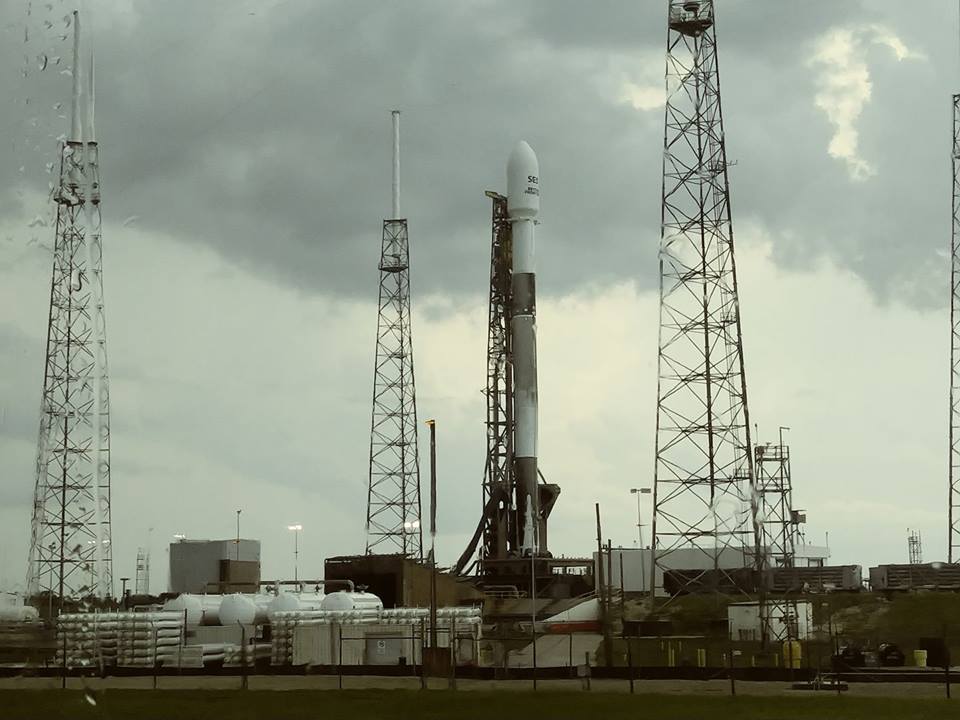
With a relatively spacious “launch window”, extending from 12:29 a.m. through 2:57 a.m. EDT for both the primary and backup dates of Thursday, 31 May and Friday, 1 June, weather conditions along the Space Coast proved bleak and unsettled. “Weather on Tuesday and Wednesday will remain unsettled, with abundant moisture aloft and a persistent upper-level trough providing instability,” noted the 45th Weather Squadron at Patrick Air Force Base. “The primary weather concern for launch is thick cloud layers.” In the L-3 weather briefing, this was expected to produce a probability of acceptable conditions at T-0 of just 30 percent, improving only slightly to 40-percent-favorable in the event of a 24-hour scrub to Thursday, 1 June. “On Thursday, unsettled conditions remain as the upper-level trough is very slow to exit, continuing the threat of afternoon showers and storms,” it was added. “The primary launch weather concern remains thick cloud layers.”
Late Monday, 28 May, SpaceX tweeted that it would forego Thursday’s launch attempt, in favor of Friday. “Team using additional time to perform pre-launch vehicle checks,” it was noted. “Also closely watching weather conditions at the Cape.” With Friday offering only marginally better odds, it was revealed that the launch window would be extended to almost four hours in duration, to hopefully increase the chances of getting SES-12 away. This ultimately proved not to be the case and by Thursday the weather and SpaceX’s need “to run additional tests on Falcon 9’s second stage” prompted a further delay until no sooner than Monday, 4 June. Following a weekend of “less storm coverage and duration”, weather conditions for the small hours of Monday were expected to increase to 70-percent-favorable, with a possible violation of the Liftoff Winds Rule expected to be the only potential show-stopper. Conditions were expected to improve yet further to 80-percent-favorable in the event of a further slip to Tuesday, 5 June. The 230-foot-tall (70-meter) Upgraded Falcon 9 was confirmed vertical on SLC-40 early Sunday morning.
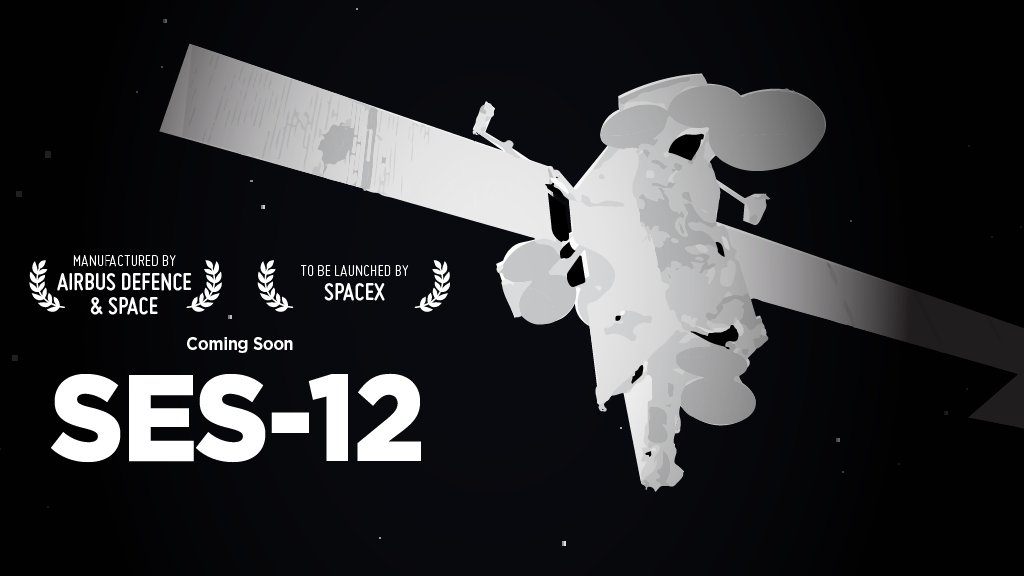
Heading into Monday’s attempt, with a similar four-hour window from 12:29 a.m. through 4:29 a.m. EDT, SpaceX initially reported a slight shift of the targeted T-0 to 12:45 a.m. A customary “Go/No-Go” poll of launch controllers was undertaken, which produced a “Go” to begin fueling the booster with liquid oxygen at T-72 minutes and loading with a highly refined form of rocket-grade kerosene (known as “RP-1”) at T-35 minutes. Passing T-10 minutes, the terminal autosequencer was initiated and the nine Merlin 1D+ engines—configured in a circle of eight, with a ninth at the center—were chilled down, prior to the ignition sequence. At T-2 minutes, the Air Force Range Safety Officer declared all ground-side assets to be “Go for Launch” and the Upgraded Falcon 9 transferred to internal power and assumed primary control of all critical functions. The Niagara deluge system flooded SLC-40 with 30,000 gallons (113,500 liters) of water, per minute, to suppress the acoustic energy. The Eastern Range announced its readiness to support the launch as “Green”. Three seconds before liftoff, the nine Merlins roared to life, ramping up to a combined thrust of 1.5 million pounds (680,000 kg).
Liftoff occurred at 12:45 a.m. EDT and the vehicle followed a perfect ascent trajectory, its first stage providing the muscle for the first 2.5 minutes, before separating. No attempt was made to recover the first stage, which is of the older “Block 4” variety. With the first stage gone, the turn came for the second stage, whose Merlin 1D+ Vacuum engine ignited for the first of two “burns” to deliver SES-12 to geostationary altitude. Generating 210,000 pounds (95,250 kg) of propulsive yield, the engine burned for 5.5 minutes, before shutting down at 12:53 a.m. The stack then coasted for approximately 17.5 minutes, before the Merlin 1D+ Vacuum was re-lit for about a minute to position the payload for deployment. SES-11 was successfully released a little more than 32 minutes after launch. “Successful deployment of SES-12 to a geostationary transfer orbit confirmed,” SpaceX tweeted at 1:19 a.m. After several weeks of on-orbit checkout, the satellite will enter operation at 95 degrees East longitude, where it is expected to remain in service for 15 years.
FOLLOW AmericaSpace on Facebook!
Missions » Commercial Space » SES »




